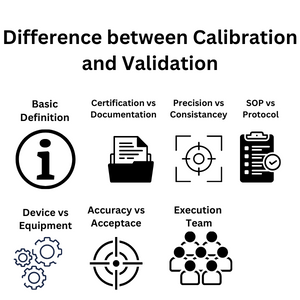Knowing the difference between calibration and validation is necessary because these two are easily confused.
Calibration and Validation are the two most essential processes in the pharma industry. Pharmaceutical product manufacturers must perform these two activities authentically and systematically to manufacture the product and acquire regulatory body compliance safely. However, the difference between calibration and validation is often confused.
As a result, deviation occurs in their process, documentation, and execution, which leads to a warning from the regulatory body or even suspension of production operations.
Why difference between calibration and validation is confused?
Some reasons that make them confused with each other are as follows
Maintenance Aid
The results of both processes can be used as an aid in maintenance to point out any deviations, faults, and errors. These are also used to verify the maintenance activities performed on equipment.
Documented Processes
Both processes require proper documentation and record-keeping. Regulatory bodies review this documentation during their routine inspection.
The quality department is responsible.
In most cases, the quality department is responsible for executing these processes. It is also responsible for presenting the case before the regulatory body during the inspection. The quality department is also responsible for planning and conducting these activities.
The similarities mentioned above cause deviation in their execution, and as a result, one process remains incomplete, or their requirements remain insufficient. It can result in regulatory non-compliance and affect the production process, equipment performance, and output product.
Difference between Calibration and Validation

Let’s discuss the difference between calibration and validation and see how they differ.
Basic Definition
Calibration is the process of checking and verifying accuracy in measuring instruments. It points out deviation and the amount of variation in that particular instrument. It is performed by comparing the output of the desired instrument with an instrument’s output which is accurate and error-free. Its primary purpose is to ensure the preciseness of measurement performed by a measuring instrument.
Validation activity is “documented evidence, which provides a high degree of assurance that a specific process will constantly produce a product meeting its pre-determined specifications and quality attributes.” It is performed for a pharmaceutical process or equipment, not for a single measuring instrument.
Execution team
Third-party vendors outside of the organization often perform calibration. The third-party maintains and uses its instrument, verified by ISO certified laboratory. The third-party vendor has the necessary skills, expertise, and resources to perform the calibration effectively. The third-party vendor is also responsible for completing associated records such as certificates and tags. A pharma organization can also maintain its resources for performing the calibration. However, it requires a lot of resources, arrangements, and technical expertise, which becomes costly for a pharma product manufacturer to execute a quarterly or half-yearly calibration cycle.
The organization itself often performs validation. For this purpose, an in-house team is constituted. The in-house team consists of the Quality, Engineering, and production department. The team performs all the processes involved in a validation activity from start to finish, such as scheduling, planning, documentation, and execution.
Accuracy vs Acceptance Criteria
In calibration, the instrument is tested and verified for accuracy. It means the output should follow standard reference values for a given input pattern, regardless of the external and operating conditions. The instrument manufacturer defines the accuracy and cannot be altered by the instrument buyer. Any deviation in output is considered inaccurate, and the instrument cannot be used without replacement, repair, or maintenance.
In validation, the process or equipment is tested and verified against acceptance criteria, which the equipment buyer defines. The equipment manufacturer has no control over acceptance criteria and is bound to manufacture the equipment according to the acceptance criteria. The manufacturer takes input from the buyer and incorporates it in the design and construction of the equipment or process.
Measuring device VS Equipment or Process
Calibration is performed for measuring device, which is used to measure any physical or digital parameter. The output of these devices is used by equipment or process, and their working depends on the correct functioning of these measuring devices.
Validation is performed for a process or equipment. The process or equipment comprises various small processes and can use measuring devices or instruments.
Certification VS Documentation
Calibration activity is concluded with a certificate depicting every calibration detail, such as calibrating parameter, frequency, output, and result. The certificate acts as proof of calibration for the given parameter and can be used as a reference document.
Validation requires complete documentation of each and individual stage. The documentation is not only a certificate. Instead, it contains every minute detail, such as planning, test procedure, acceptance criteria, and deviation list of each stage, such as IQ, OQ, and PQ.
Precision VS Consistency
In calibration, the instrument is verified for precision against standard results.
In validation, the process or equipment is tested for consistency.
SOP Vs Protocol
Calibration is performed according to an SOP, which only includes the procedure for performing calibration for a specific instrument. The SOP does not include additional information such as documentation, planning, execution, and a further line of action.
Validation is performed according to a validation protocol. It includes the procedure from start to finish and provides detail of every aspect of validation. For example, a validation protocol includes information related to documentation, deviation management, planning, scheduling, and future line of action.
Process VS Product
In calibration, the effect is felt in the process. Since the production process depends on the output of a measuring instrument, any error or drifts in the output of a measuring device negatively affect the process.
In validation, the effect is felt on the final product. If validation fails, the product is affected. Similarly, a successful validation has a positive impact on the final product.

